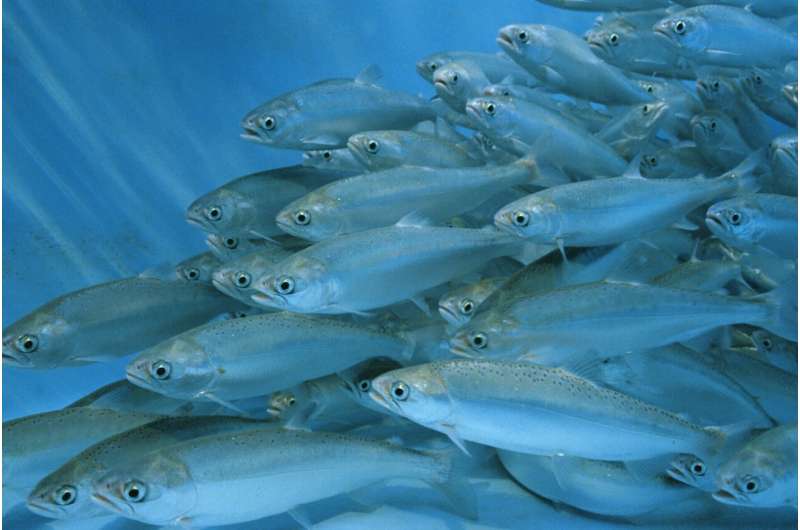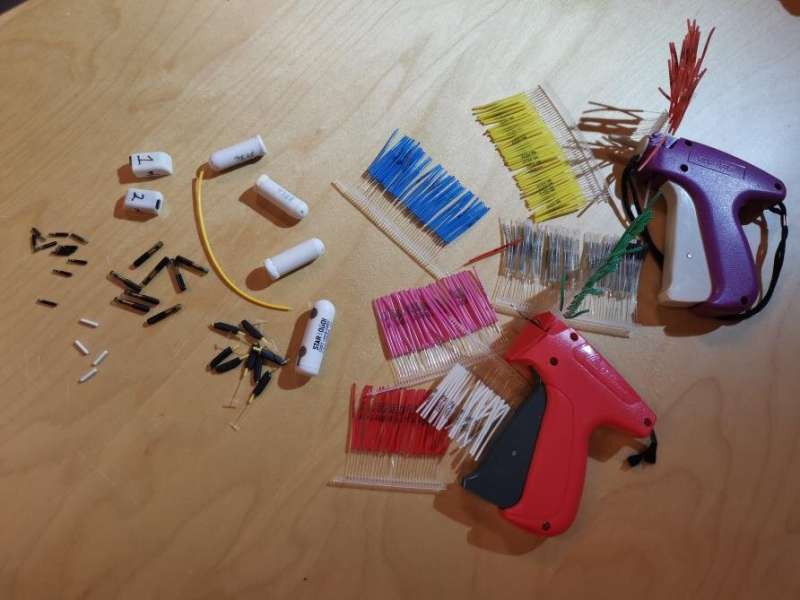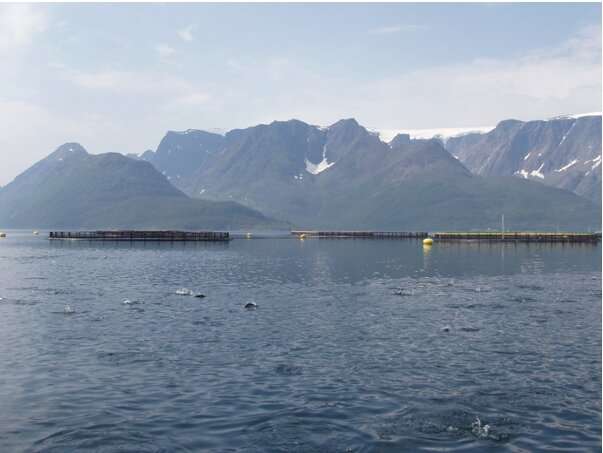Farmed salmon. Credit: Frode Oppedal
Aquaculture is becoming increasingly important as a source of food for our growing population. Worldwide, billions of fish are farmed and eaten every year, and humans now consume more farmed than wild caught fish.
As aquaculture production expands, however, the behavior of many species of farmed fish remains a mystery.
We have a responsibility, both economic and ethical, to look after the welfare of animals we farm, but this lack of knowledge creates key challenges when it comes to animal husbandry in aquaculture.
For millennia, farmers have watched and learnt from their animals, and adapted their farming methods to improve animal welfare and production.
When farm animals behave abnormally this usually suggests something is wrong. For instance, a dairy cow with lameness will spend more time lying down than a healthy cow.
But the underwater lives of fish makes their care trickier. They are out of sight beneath the surface, and individuals are anonymous in the huge schools of fish in the tanks and cages they are kept in.
Using tags is one way to better understand the secret lives of fish underwater.
Tagging fish is not a new practice—tags were first used in the 1870s to follow migration routes of salmon. Early tags were simple lengths of copper or silver metal that were attached to the fish's dorsal muscles, but with modern electronics, tags have undergone a rapid and recent technological evolution.
Tags can now record, store and relay complex datasets measured every second for days, or more slowly over months and years.
Tags can measure information previously impossible to get—like heart rate, body temperature, the environments fish experience and their location in three dimensions. Some tags can transmit data wirelessly in real-time, allowing researchers to see what fish are doing as they are doing it.
Our group of research scientists from the University of Melbourne, Institute of Marine Research Norway (IMR) and the Norwegian University of Science and Technology have used tags to investigate the response of farmed salmon to parasites, track how salmon swim in new cage environments and test their ability to learn new behaviors.
This work has led to remarkable new insights that have improved how fish are treated for damaging parasites, how they respond to poor conditions and how fish can learn to adapt to life in farms.
Tag types and applicators, from simple t-bar tags (multi-coloured tags with aplicator guns) to various electronic tags that are surgically inserted into the body cavities of fish (left). Credit: Frode Oppedal
Through this work, we noticed tags do not always work as intended, and sometimes tags affected the fish negatively.
If tags are to provide useful information relevant to the whole population of untagged fish, the behavior and welfare of tagged fish must not be compromised by the tagging process. But if tags change the behavior or welfare of fish, the information they give may not represent the wider untagged population.
So we decided to dig deeper.
With funding from the Research Council of Norway, we systematically reviewed studies that used tags to monitor farmed fish behavior.
Several concerning discoveries emerged.
Firstly, tagged fish mortality was 10 times higher in studies conducted in sea-cages where fish are held, compared to tanks. Sea-cage aquaculture is conducted in floating cages attached to moorings in the sea that are open to the wider marine environment.
In sea-cages, one in four tagged fish died within the period they were studied, and in general, the longer the study, the higher the mortality rate. And in many studies, important information, like the mortality rates of tagged and untagged fish, was not reported which makes it difficult to work out the effects of tags.
So why are mortality rates so high in sea-cages and why do they differ from tank studies?
Experiments conducted in small tanks are typically done under more controlled culture conditions, where researchers can largely prevent poor water quality and other adverse events, like algal blooms or pollution.
In comparison, experiments conducted in large sea-cages in the ocean filled with thousands to millions of individuals expose fish to stressful environments (with fluctuating temperature, salinity, dissolved oxygen, current, pollutants and pathogens) which can affect their behavior, welfare and survival.
These findings have several implications:
(i) results obtained in tanks are likely not generalisable to sea-cage environments
Salmon farm in a northern Norwegian fjord. Credit: Tim Dempster
(ii) high mortality rates in sea-cage experiments call into question how representative tagged fish are of the whole fish population; and
(iii) with such high mortality rates in tagged fish in sea-cages, tagging in this environment creates significant animal welfare issues.
Tagging is stressful for fish—being captured, handled and undergoing surgery are not experiences a fish would normally go through. In sea-cages, fish are also exposed to other stressful conditions like crowding or environmental extremes—and unlike the wild, caged fish cannot swim away from unpleasant conditions.
We think the additional stressors present in the sea-cage environment make it harder for fish to recover from the initial stress of tagging and that this leads to a lower chance of survival.
Based on our results, we recommend more rigorous use of the '3Rs' framework when tagging fish in aquaculture, which are the guiding principles for humane use of animals in scientific studies and include:
- Replacement, which encourages removing the use of animals completely;
- When animals must be used, Reduction minimizes the number of animals being used;
- Refinement ensures research methods are advanced so that animals experience the least amount of suffering possible.
In our review, published in the journal Reviews in Aquaculture, we suggest replacement of tags where possible with unobtrusive, behavioral monitoring technologies, like sonar, video or computer imaging.
These alternatives will not work for every study, so where researchers need to use tags we recommend that the number of fish tagged is reduced to a minimum that will still provide large enough sample sizes to get relevant results.
We also have recommendations for future tagging research to refine the tagging procedure by encouraging researchers to:
- carefully record the tag attachment procedure, including important information like tag dimensions, water temperature and type of anesthetic used;
- provide information about any physical effects from tagging, such as if fish display inflammation near the tag attachment site;
- compare the behavior of tagged and untagged fish throughout the experiment;
- report how many tagged fish and how many untagged fish died throughout the experiment.
By reporting this information, it should allow researchers to determine whether tags are negatively affecting the welfare and survival of their experimental fish—and whether or not it's a good idea to use data from tagged fish to make assumptions about untagged fish.
Our results shed light on a practice that is gaining popularity—but needs considerable improvement to ensure it is a safe method for fish, which also produces reliable results.
As tagging technology become cheaper and more sophisticated, tags will continue to be a popular choice among scientists who research farmed fish. While tagging has a lot of promise, it needs significant improvement to safeguard the welfare of tagged fish in aquaculture.
More information: Georgia Macaulay et al. Tag use to monitor fish behaviour in aquaculture: a review of benefits, problems and solutions, Reviews in Aquaculture (2021). DOI: 10.1111/raq.12534
John R. Moring. Marking Experiments with Atlantic Salmon in the United States in the 1870s and 1880s, Fisheries (2004). DOI: 10.1577/1548-8446%282002%29027%3C0021%3AMEWASI%3E2.0.CO%3B2
Journal information: Fisheries
Provided by University of Melbourne


























